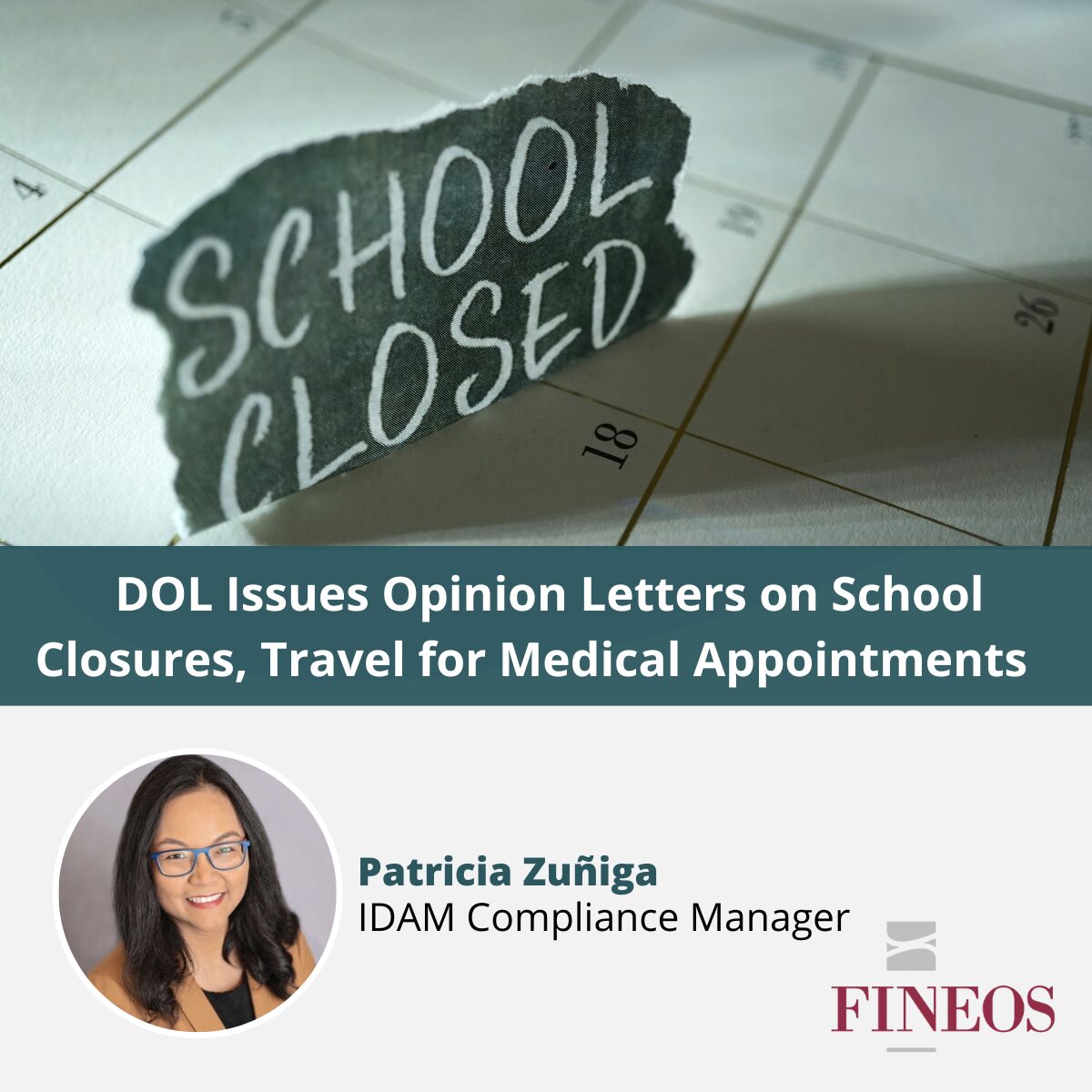FMLA and Employee Dual-Notice Procedures – Stand Your Ground But Be Clear About Your Policies |
A collaborative post by:
- Megan Holstein, Esq., Senior Vice President, Absence & Claims Product, FINEOS
- Gail Cohen, Director, Employment Law and Compliance, Matrix Absence Management
- Marti Cardi, Esq., Vice President Product Compliance, Matrix Absence Management
QUESTION: Can an employer require an employee taking FMLA leave to report absences to both a supervisor and a leave administrator?
ANSWER: It depends – but probably yes. Read on!
The Issue
Employers are struggling with the trend in rising employment time off benefits caused by the numerous new state laws requiring job-protected leave and increasing company leave benefits due to competition for workers. In response, many employers have strengthened their absence policies. Whether the employer outsources absence management or insources with a centralized administrative or human resources (HR) department, an employee must provide notification that they need time off in order for that leave to be approved and not counted against the employee’s attendance record.
The federal Family and Medical Leave Act (FMLA) regulations address employee notification by requiring an employee to “comply with the employer’s usual and customary notice requirements for requesting leave, absent unusual circumstances.” 29 C.F.R. §825.302(d); §29 C.F.R. 303(c). The FMLA supports employers who have a reporting notice policy by allowing an employer to delay or deny FMLA leave if an employee does not comply with the employer’s policy and no usual circumstances justify the failure to do so. Accordingly, many employers’ absence notice requirements or FMLA policies require an employee to contact both a supervisor and a centralized absence administration office, whether that is an internal HR or Benefits department or outsourced to a third party administrator (TPA); otherwise known as a dual-notice, or two-party call in policy or procedure.
Employees have contested dual-notice policies in court claiming they violate the FMLA by interfering with their right to take FMLA leave. Courts have historically supported employers dual-notice policies. However, a recent Alabama district court decision, LaShondra Moore v. GPS Hospitality Partners IV, LLC, declined to follow other courts’ support and instead found that an employer’s dual-notice policy that required employees to contact both HR and their manager when reporting absences violated the FMLA. While this decision is an outlier, there are still lessons to learn from the case. Read on to learn more about courts’ approaches to dual-notice policies and whether the DOL might weigh in.
Bad Facts Make Bad Law.
LaShondra Moore worked for a Burger King franchise that was one of nearly 200 purchased by GPS. The new owner required the employees of the purchased locations to complete new paperwork, including reviewing and acknowledging the employee handbook. The handbook included GPS’s FMLA policy and the requirement to report FMLA absences to store managers and to the centralized HR office. When Moore’s mother became ill and was hospitalized, she informed her manager multiple times of her need to take time off from work to care for her mother. In spite of awareness that Moore’s absences were the result of her mother’s hospitalization, Moore’s manager issued disciplinary action and ultimately terminated her due to these absences.
Ms. Moore sued for FMLA interference in federal court. GPS based its defense on its employee handbook, which set forth an FMLA policy requiring the employee to notify their supervisor and HR of their need for FMLA leave.
The Court’s Approach to GPS’s Dual-Notice policy.
Citing the FMLA notice regulations allowing an employer to require an employee to comply with its notice requirements for requesting leave, the court took great exception to the notion that GPS’s policy required employees to do more – notify both a supervisor and HR – to request FMLA than other types of leave. Essentially, the court found that employers can only maintain a dual notice reporting policy only if the policy applies to all types of leave requests, not just FMLA.
This Case is an Outlier.
Several courts that have heard claims by employees who have been disciplined for not following their employer’s dual reporting policies have drawn conclusions opposite to the Moore court. Here is a sampling of those cases:
- 3rd Circuit – E.D. Pennsylvania – IBW v. PPL Electric Utilities Corp. (December 2017) – Relying on the Acker case (discussed below) and concluding no FMLA violation in connection with employer policy requiring employees to report absences to their supervisor and “make a three to five minute phone call to a third party administrator.”
- 5th Circuit – Acker v. General Motors, LLC (April 2017) – Judgment in favor of the employer on FMLA interference and retaliation claims when employee failed to follow GM call-in procedures, of which he was reminded by GM’s TPA. In doing so, the court noted that “[f]ormal notice of absence policies serve an employer’s legitimate business interests in keeping apprised of its employees and ensuring that it has an adequate workforce to carry out its normal operations.”
- 6th Circuit – Srouder v. Dana Light Axle Mfg. (2013) – Sixth Circuit affirmed the judgment in the employer’s favor on an interference claim and that the termination of the plaintiff’s employment was appropriate because he failed to comply with the employer’s call-in policies.
- Also in the Sixth Circuit, Alexander v. Kellogg USA Inc., (January 6, 2017), the court again rejected an FMLA interference claim challenging the termination of employment on the basis of the plaintiff’s failure to report intermittent FMLA absences to both his employer and its TPA.
- 7th Circuit – N.D. Indiana– Reese v. Zimmer Production, Inc. (September 2018) – The court concluded that the employee failed to comply with his employer’s policy, which required him to notify his supervisor and the company’s TPA to initiate a request for FMLA.
- 9th Circuit – Duran v. Stock Building Supply West, LLC (January 2017) – The court held that the employee’s failure to complete an internal LOA request form and provide certification to the employer’s TPA, both mandated by its customary notice policies, doomed his FMLA/CFRA interference and retaliation claims.
Also in the 9th Circuit, the most recent case – Rozairo v. Wells Fargo (D. Oregon, July 17, 2019) in which the court relied on the employer’s policy requiring employees to discuss their request for leave with their manager and call its TPA, finding the employee who failed to comply with that policy for initiating leave could not state claims for violations of FMLA or Oregon’s state equivalent, the Oregon Family Leave Act.
Will the U.S. Department of Labor (DOL) Weigh In?
The DOL announced that it is considering revising the FMLA regulations by announcing its plans to publish a request for information (RFI) next spring to solicit comments to improve the FMLA regulations in two ways:
- Better protect workers; and
- Reduce employers’ FMLA compliance and administrative
We think this area of the FMLA regulations governing an employer’s ability to set forth absence notice policies and procedures is ripe for further clarification.
For more information regarding the DOL’s plan to publish an RFI, read Megan Holstein’s blog, “Changes to the FMLA are on the horizon” and our friend, Jeff Nowak, has a blog here.
Pings for Employers:
- The weight of authority supports that an employer can require employees to report FMLA absences to two sources.
- But, it may not be enough to simply place your absence request policy in the employment handbook. Employers should broadcast the policy in ways employees can access it, including:
- highlight the policy on a company intranet and send email reminders;
- post the policy and FMLA posters in the breakroom and any other venue in which employees may congregate;
-
- consider holding informational meetings about all of your benefits, including FMLA and other leave benefits and how to request the time off; and
- if using a TPA, engage the TPA as a source and additional reason for further outreach to employees. Make sure they understand who your TPA is, what purposes they serve, and how to contact the TPA.
- Keep your dual-notice policy simple and clear. Do not require employees to be FMLA, state leave, or benefits experts to navigate your policy. They don’t need to know when leave is FMLA and therefore the TPA must be contacted or, for example, when it’s a common cold and only a manager needs notification. Instead, streamline the policy to notice categories such as reasons for leave (e.g., vacation, care of family member, employee illness, parental leave, etc.) and/or duration of leave (e.g., absences of fewer or more than 3 days).
- On the other hand, do train your manager to be issue spotters and recognize when an employee’s request might be time off for an FMLA-qualifying reason. Managers not only need to spot when a request may be covered by the FMLA, but they must know the reporting policy and be able to inform the employee how to correctly report an absence under the policy so that the request can be evaluated by the right people, such as a TPA or HR. Then teach them to hand the issue off to those right people and not try to handle it themselves – they should be grateful for that!
Simplify the complex with FINEOS Absence that supports federal, state, municipal, state-mandated and employer PFML plans. The FINEOS Integrated Disability and Absence Management (IDAM) solution brings together the robust FINEOS Absence, the market-leading FINEOS Claims and FINEOS Payments to develop a single book of record for all absence management related services, including workplace accommodations to facilitate stay-at-work and return-to-work. If you’re ready to simplify the complex landscape of absence management, contact us at info@FINEOS.com.


